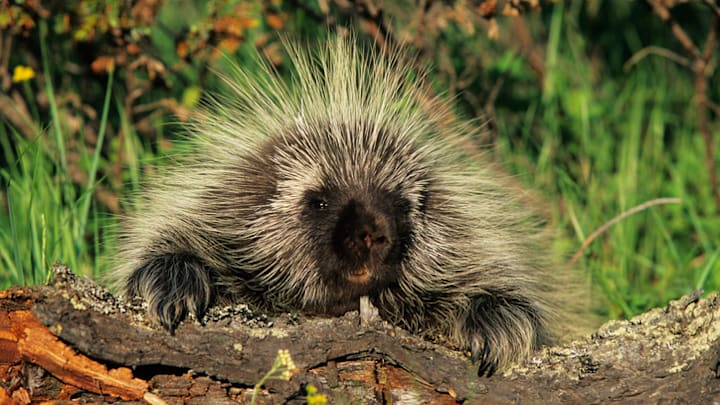Porcupines might be considered a prickly bunch, but you’ll discover these animals are quite docile once you learn more about them.
1. The origin of porcupine can be traced back to Old French.
The word porcupine is a derivative of the Old French phrase porc-espin, meaning “spiny hog.” Middle and Early Modern English variants included porkenpick and porkpen, as well as porpentine, Shakespeare’s version in Hamlet.
2. Porcupines are the third-largest rodents in the world, and the second largest in North America.

They’re behind beavers (in second place) and capybaras, the reigning champs, which are native to South America.
3. Porcupines cannot throw their quills.
When a porcupine feels threatened, it tenses up and attacks predators with a swat of its quill-covered tail. Some quills may become embedded into the predator’s skin. Occasionally, loose quills fall out before it strikes, creating the illusion that they're being shot from the porcupine’s body, but porcupines can’t actually eject them.
4. A porcupine has approximately 30,000 quills on its body.

A typical porcupine has soft hair mixed in with quills, which grow from its back, sides, and tail.
5. There are two families of porcupines.

Old World porcupines in the family Hystricidae live in southern Europe, Asia, and Africa. New World porcupines in the family Erethizontidae are indigenous to North and South America. There are 23 species of porcupine worldwide.
6. Old World porcupines may not be good climbers, but they are excellent swimmers.
New World porcupines, on the other hand, are adept at climbing trees. They are capable of clinging to branches with their tails and catching surrounding branches and twigs if they fall.
7. They are nocturnal herbivores.
Porcupines are primarily creatures of the night that rest in hollow logs, trees, and crevices during the day, and come out at dusk to feast on tree bark, grass, twigs, stems, berries, and the like.
8. Their quills are antibiotic.
Each quill is coated with a topical antibiotic—a self-defense mechanism to prevent infection by accidental self-quilling. If you get stuck with quills, the injury won’t necessarily lead to an infection for that reason.
9. Baby porcupines have soft quills at birth, which harden within a few days.
When they grow accustomed to fending for themselves at about 6 months old, baby porcupines—called porcupettes— leave their mothers.
10. Porcupine quills have overlapping barbs that make them hard to remove.
Each quill boasts between 700 and 800 barbs along its tip.
11. The porcupine mating ritual involves peeing.
Typically, two male porcupines fight over a single female. The males are careful not to injure themselves during the fight, and the winner urinates on the female so that she knows to move her tail aside for safe, quill-free mating.
A version of this story was published in 2015; it has been updated for 2024.
